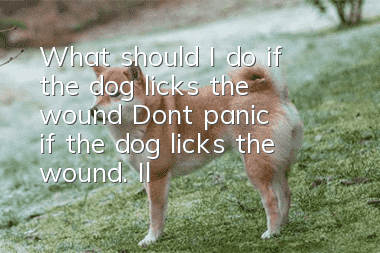What should I do if the dog licks the wound? Don’t panic if the dog licks the wound. I’ll tell you when you need an injection.

Only if a rabid dog licks an obvious wound will you get rabies
Don’t panic if you are licked by a dog. First, make sure that the dog licking you has rabies. Rabies. Whether you get rabies if you are licked by a dog depends on the situation. 1. First of all, if the dog is already suffering from rabies and the skin is licked without any damage to the skin, it will not be infected with rabies. 2. If the dog is already suffering from rabies, humans come into contact with the sick dog without wounds. Dog blood and feces are not contagious and no preventive measures are required. 3. Rabies will be quickly inactivated in a normal environment and will not be transmitted through objects licked by saliva. 4. Rabies virus does not spread through the air. After being licked by a dog, wash the wound with soap and water immediately
Regardless of whether the dog that licked the wound has been vaccinated against rabies, the wound must be rinsed thoroughly first. 1. First, rinse the wound with plenty of water. Do not touch it with your hands or other parts to avoid bacteria. 2. Clean the wound with 20% soapy water (soap is also acceptable), or disinfect it with iodine. Do not bandage the wound, but keep it exposed. Inject rabies globulin or serum into the muscle around the wound to neutralize rabies. poison. 3. Repeat actions 1.2 for at least 15 minutes, ensuring that actions 1.2 are performed alternately. Use soap after rinsing, rinse again, and use soap again. 4. Go to the hospital or epidemic prevention department to get vaccinated.Being bitten, scratched, or licked by an animal depends on the level of rabies exposure
If you are in an epidemic area (all of my country is an epidemic area) and are infected by rodents Or bite, scratch or lick wounds from lagomorphs, etc., and if you also observe diseases or abnormal behaviors in these animals, please take appropriate measures according to the rabies exposure situation.
Level I exposure: There has been contact with an animal, but your skin is intact and there is no injury. Level II exposure: nibbling on exposed skin, or minor scratches or abrasions without bleeding. To put it simply, it means that you are injured but not bleeding. (When it is difficult to judge a small wound with the naked eye, you can wipe the damaged area with alcohol. If there is pain, it is grade II, if there is no pain, it is grade I, and if it is not certain, it is grade II. It should be noted that this method is only suitable for injuries caused by The wound was used at the time.) Level III exposure: single or multiple penetrating skin bites or scratches; or broken skin being licked; or open wounds or mucous membranes being contaminated; exposure to bats. That is, there is bleeding injury or mucosal contact. (In addition, WHO recommends that bites occurring in nerve-rich areas such as the head, face, neck, hands, and external genitalia are also Level III exposures.) To put it simply, you only need to determine whether the skin is damaged and whether it is based on your actual situation. Bleeding and contact with mucous membranes are used to determine your level of exposure.
Random articles
- Can Chihuahuas drink pure milk? Does your dog drink milk?
- Signs that your dog is about to die. What your dog does before he dies.
- How to measure a dog’s temperature? Do you know what to pay attention to when measuring a dog’s temperature?
- Do dogs fart? Do you know what it means when a dog farts?
- What are the advantages of Teddy? After reading this, don’t you want to keep a Teddy?
- What should I do if my dog gets old? What are the characteristics of an old dog?
- The working process of guide dogs. Guide dogs need to pay tribute when working!
- Signs of an old dog. When a dog is old, it is necessary to protect the dog’s body.
- What should I do if my dog dies? What should I do if my dog dies?
- How long does it take for a Schnauzer to be pregnant? What should you know about Schnauzer birth changes?



